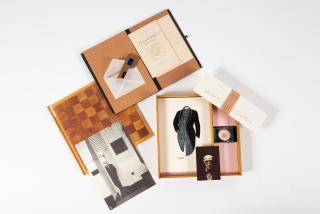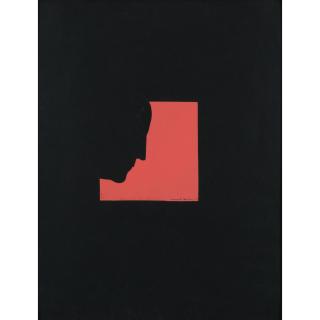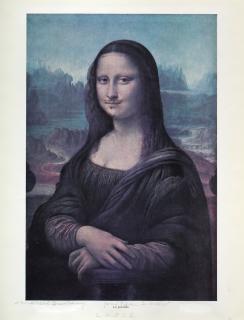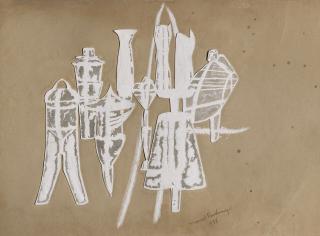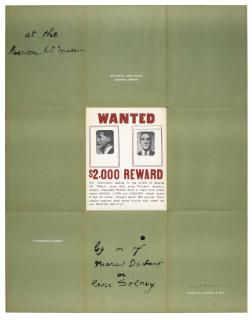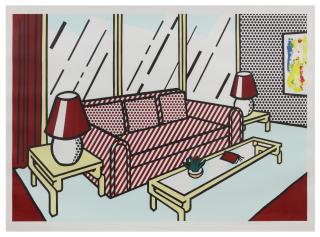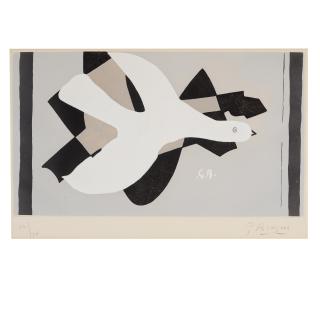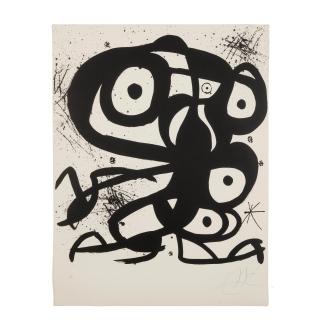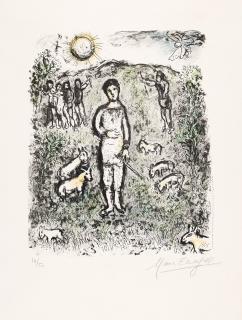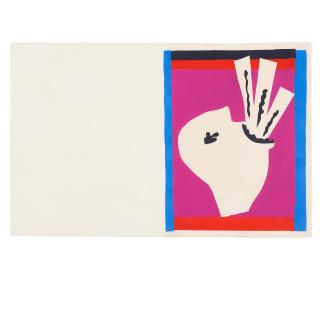Marcel Duchamp Blainville - Crevon, France 1887 - 1968 Neuilly - sur - Seine, France
The artist Marcel Duchamp
- One of the most famous artists of the 20th century with proximity to surrealism.
- Leading representative of ready-mades; form their own branch of the art form.
- Was also a gifted chess player - up to international tournaments.
Whether he is now firmly counted among the early Surrealism, is controversial. In any case, he is considered one of the leading minds of the avant-garde at the beginning of the 20th century, questioned conventional art. Marcel Duchamp did not represent a clear genre, although he was very close to Surrealism and Dadaism: he surrounded himself with figureheads like Man Ray and André Breton, but started his journey in Impressionism. Duchamp admired Paul Cézanne and tried to combine Cubist with Futurist elements when imitating Impressionist works. This is most visible in Nu descendant un escalier no. 2 (1912, Nude, Descending a Staircase No. 2).
Marcel Duchamp saw the light of day on July 28, 1887, in Blainville-Crevon, a small commune in northwestern France. Three of his siblings, Jacques Villon (1875-1963), Raymond Duchamp-Villon (1876-1918) and Suzanne Duchamp-Crotti (1889-1963), were also artistically active. His brothers are said to have introduced him to Cubism. Before Duchamp took the same path as his siblings, however, he completed a traineeship in a print shop. In 1904, he studied for a year at the Académie Julian in Paris.
Duchamp quickly abandoned classical oil painting. Instead, as early as 1914, he created his ready-mades, for which he later became so famous. Although this art form was still in its infancy with his first works, the Bicycle Wheel (1913) and the Bottle Dryer (1914), it was not long before he made history with this whimsical art - the mostly unfinished objects shook up the conventional and conservative understanding of art, they redefined the creative act.
For a few years, Duchamp devoted himself almost exclusively to chess (1928 to 1933) - and very successfully: he officially represented his native France in several tournaments. But he also organized art exhibitions and sponsored other artists.
In part, he acted under the sharp-tongued pseudonym Rrose Sélavy - a fictitious woman Man Ray portrayed him as around 1920. Duchamp always continued the surrealist-dadaist parody: shortly before the beginning of World War II, he designed portable museums, the boîte-en-valise (box in a suitcase), in which he stowed replicas of his own works in miniature format.
From 1942 until the end of the war, he stayed in New York, where he organized an exhibition with André Breton. Etant donnés: 1° la chute d'eau / 2° le gaz d'éclairage (Given: 1. The waterfall, 2. The illuminating gas) is considered the last project. The diorama-like room took twenty years to complete in 1966. It shows a photomontage with a woman undressed. In October 1968, Duchamp died in his apartment in Neuilly-sur-Seine.
Der Künstler Marcel Duchamp
- Einer der bekanntesten Künstler des 20. Jahrhunderts mit Nähe zum Surrealismus.
- Führender Vertreter von Ready-mades; bilden einen ganz eigenen Zweig der Kunstform.
- War ebenfalls begnadeter Schachspieler – bis hin zu internationalen Turnieren.
Ob er nun fest zum frühen Surrealismus zählt, ist umstritten. Allemal gilt er aber als einer der führenden Köpfe der Avantgarde zu Beginn des 20. Jahrhunderts, stellte konventionelle Kunst in Frage. Marcel Duchamp vertrat kein eindeutiges Genre, obgleich er dem Surrealismus und dem Dadaismus sehr nahestand: Er umgab sich mit Galionsfiguren wie Man Ray und André Breton, startete seine Reise aber im Impressionismus. Duchamp bewunderte Paul Cézanne und versuchte bei der Nachahmung impressionistischer Werke kubistische mit futuristischen Elementen zu verbinden. Sichtbar ist dies vor allem in Nu descendant un escalier no. 2 (1912, Akt, eine Treppe hinabsteigend Nr. 2).
Marcel Duchamp erblickte am 28. Juli 1887 in Blainville-Crevon, einer kleinen Gemeinde im Nordwesten Frankreichs, das Licht der Welt. Drei seiner Geschwister, Jacques Villon (1875-1963), Raymond Duchamp-Villon (1876-1918) und Suzanne Duchamp-Crotti (1889-1963), waren ebenfalls künstlerisch tätig. Seine Brüder sollen ihn auf den Kubismus gebracht haben. Bevor Duchamp aber denselben Weg wie seine Geschwister einschlug, absolvierte er ein Volontariat in einer Druckerei. 1904 studierte er für ein Jahr an der Académie Julian in Paris.
Schnell gab Duchamp die klassische Ölmalerei auf. Stattdessen entwarf er schon 1914 seine Ready-mades, für die er später so bekannt wurde. Zwar steckte diese Kunstform mit seinen ersten Arbeiten, dem Fahrrad-Rad (1913) und dem Flaschentrockner (1914), noch in den Kinderschuhen, doch dauerte es nicht mehr lange, bis er mit der skurrilen Kunst Geschichte schrieb – die meist unbearbeiteten Objekte rüttelten am konventionellen und konservativen Kunstverständnis, sie definierten den kreativen Akt neu.
Für einige Jahre widmete sich Duchamp beinahe ausschließlich dem Schachspiel (1928 bis 1933) – und zwar sehr erfolgreich: Bei einigen Turnieren vertrat er offiziell sein Heimatland Frankreich. Er organisierte aber auch Kunstausstellungen und protektierte andere Künstler.
Teils agierte er unter dem spitzzüngigen Pseudonymen Rrose Sélavy – eine fingierte Frau, als die Man Ray ihn um 1920 herum porträtierte. Die surrealistisch-dadaistische Parodie setzte Duchamp stets fort: Kurz vor Beginn des Zweiten Weltkrieges entwarf er tragbare Museen, die Boîte-en-valise (Schachtel im Koffer), in denen er Replika seiner eigenen Werke im Miniaturformat verstaute.
Ab 1942 hielt er sich bis zum Ende des Krieges in New York auf, wo er zusammen mit André Breton eine Ausstellung organisierte. Als letztes Projekt gilt Etant donnés: 1° la chute d’eau / 2° le gaz d’éclairage (Gegeben sei: 1. Der Wasserfall, 2. Das Leuchtgas). Der Diorama-ähnliche Raum benötigte zwanzig Jahre bis zur Fertigstellung im Jahr 1966. Es zeigt eine Fotomontage mit einer entkleideten Frau. Im Oktober 1968 starb Duchamp in seiner Wohnung in Neuilly-sur-Seine.
Marcel Duchamp in a nutshell
Readymades are works of art that consist of already existing objects and become a finished work through minimal adaptation by the artist. Duchamp tested the limits of art and the power of the artist with this approach. To this day, people express irritation with this understanding of art. Duchamp exhibited 13 readymades over the course of 30 years. The most famous is Fountain (1917), a lying, signed urinal. Contrary to what the term readymade suggests, the found object is not in itself a work of art; rather, it requires processing by an artist. In this case, by laying down the urinal, so that a completely new visual experience is created.
Some art historians doubt that Duchamp is the creator of Fountain. Letter correspondence suggests that the Dada artist Elsa von Freytag-Loringhoven could be the inventor.
Yes, Duchamp at times even put art to rest for some time and devoted himself entirely to chess. He won a few tournaments and played for the French national team. Duchamp also made his own chess pieces.
Häufige Fragen zu Marcel Duchamp
Readymades sind Kunstwerke, die aus bereits existierenden Objekten bestehen und durch minimale Anpassung vom Kunstschaffenden zum fertig Werk werden. Duchamp testete mit diesem Vorgehen die Grenzen der Kunst und die Macht des Künstler aus. Bis heute zeigen sich die Menschen irritiert von diesem Kunstverständnis. Duchamp stellte im Verlauf von 30 Jahren 13 Readymades aus. Das berühmteste ist Fountain (1917), ein liegendes, signiertes Urinal. Anders als der Begriff Readymade es vermuten lässt, ist das gefundene Objekt an sich noch kein Kunstwerk, sondern es ist eine Bearbeitung durch einen Kunstschaffenden nötig. In diesem Fall durch das Hinlegen des Urinals, sodass ein völlig neues Seherlebnis entsteht.
Manche Kunsthistoriker bezweifeln, dass Duchamp der Urheber von Fountain ist. Briefkorrespondenzen lassen vermuten, dass als Erfinderin die Dada-Künstlerin Elsa von Freytag-Loringhoven in Frage kommt.
Ja, Duchamp hat zeitweise sogar für einige Zeit die Kunst ruhen lassen und sich völlig dem Schachspiel gewidmet. Er gewann ein paar Turniere und spielte für das französische Nationalteam. Duchamp stellte auch eigene Schachfiguren her.


